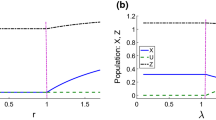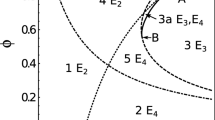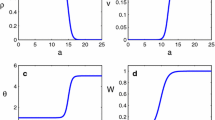Abstract
Parasite and predator play significant role in trophic interaction, productivity and stability of an ecosystem. In this paper, we have studied a host-parasite-predator interaction that incorporates incubation delay. How the qualitative and quantitative behaviors of the system alter with the incubation delay have been discussed both from mathematical and biological point of views. It is observed that for a lower infection rate, the system is stable for all delays; but for a higher infection rate, there exists a threshold value of the delay above which the system is unstable and below which the system is stable leading to the persistence of all the species. Also, the instability arising from the incubation delay may be controlled if somehow the growth rate of predator population is increased. Numerical studies have also been performed to illustrate different analytical findings.
Similar content being viewed by others
References
Adams, V.D., De Angelis, D.L., Goldstein, R.A., 1980. Stability analysis of the time delay in a host parasitoid model. J. Theor. Biol. 83, 43–2.
Anderson, R.M., May, R.M., 1991. Infectious Diseases of Humans—Dynamics and Control. Oxford University Press, London.
Arriola, L., Hyman, J., 2005. Lecture Notes, Forward and Adjoint Sensitivity Analysis: with Applications in Dynamical Systems, Linear Algebra and Optimization. Mathematical and Theoretical Biology Institute.
Chattopadhyay, J., Arino, O., 1999. A predator-prey model with disease in the prey. Nonlinear Anal. 36, 747–66.
Chattopadhyay, J., Bairagi, N., 2001. Pelicans at risk in Salton Sea—an eco-epidemiological study. Ecol. Model. 136, 103–12.
Cohn, J.P., 2000. Saving the Salton Sea. Bioscience 50(4), 295–01.
Culshaw, R.V., Ruan, S., 2000. A Delay-differential equation model of HIV infection of CD4+ T-cells. Math. Biosci. 165, 27–9.
Culshaw, R.V., Ruan, S., Webb, G., 2003. A mathematical model of cell to cell spread of HIV-1 that includes a time delay. J. Math. Biol. 46, 425–44.
Curio, E., 1988. Behavior and parasitism. In: Mehlhorn, H. (Ed.), Parasitology in Focus. Springer, New York.
Dieudonne’ J., 1960. Foundations of Modern Analysis. Academic, New York.
Dobson, A.P., Hudson, P.J., 1992. Regulation and stability of a free-leaving host-parasite system, Trichostrongylus tenuis in red grouse. II. Population models. J. Anim. Ecol 61, 487–00.
Dwyer, G., Dushoff, J., Yee, S.H., 2004. Generalist predators, specialist pathogens and insect outbreaks. Nature 43, 341–45.
Fenton, A., Rands, S.A., 2006. The impact of parasite manipulation and predator foraging behavior on predator-prey communities. Ecology 87(11), 2832–841.
Freedman, H.I., Rao, V.S.H., 1983. The trade-off between mutual interference and time-lags in predator-prey systems. Bull. Math. Biol. 45, 991.
Freedman, H.I., Addicot, J.F., Rai, B., 1987. Obligate mutualism with a predator: stability and persistence of three species models. Theor. Popul. Biol. 32, 157–75.
Freeland, W.J., 1983. Parasites and coexistence of animal host species. Am. Nat. 121, 223–36.
Friend, M., 2002. Avian disease in the Salton Sea. Hydrobiologia 473, 293–06.
Gonzalez, M.R., Hart, C.M., Verfaillie, J.R., Hurlbert, S.H., 1998. Salinity and fish effects on Salton Sea microecosystems: water chemistry and nutrient cycling. Hydrobiologia 381, 105–28.
Gopalsamy, K., 1992. Stability and Oscillations in Delay Differential Equations of Population Dynamics. Kluwer Academic, Dordrecht.
Hadeler, K.P., Freedman, H.I., 1989. Predator–prey population with parasite infection. J. Math. Biol. 27, 609–31.
Hassard, B.D., Kazarinoff, N.D., Wan, Y.H., 1981. Theory and Application of Hopf Bifurcation. Cambridge University Press, Cambridge.
Hethcote, H.W., Levin, S.A., 1989. Periodicity in epidemiological models. In: Gross, L., Levin, S.A. (Eds.), Applied Mathematical Ecology, pp. 193–11. Springer, New York.
Holling, C.S., 1965. The functional response…population regulation. Memories of the entomological society of Canada, 45, pp. 1–0.
Holmes, J.C., Bethel, W.M., 1972. Modification of intermediate host behavior by parasites. In: Canning, E.V., Wright, C.A. (Eds.), Behavioral Aspects of Parasite Transmission. Suppl. I to Zool. f. Linnean Soc., vol. 51, pp. 123–49.
Horvitz, S., 1999, http://www.sci.sdsu.edu/salton/Salton%20Sea%20Description.html.
Hudson, P.J., Dobson, A.P., Newborn, D., 1992. Do parasites make pray vulnerable to predation? Red grouse and parasites. J. Anim. Ecol. 61, 681–92.
Hudson, P.J., Newborn, D., Dobson, A.P., 1992. Regulation and stability of a free-leaving host-parasite system, Trichostrongylus tenuis in red grouse. I. Monitoring and parasite reduction experiment. J. Anim. Ecol. 61, 477–86.
Hudson, P.J., Dobson, A.P., Newborn, D., 1998. Prevention of population cycles by parasite removal. Science 282, 2256–258.
Ives, A.R., Murray, D.L., 1997. Can sublethal parasitism destabilize predator-prey population dynamics? a model of snowshoe hares predators, and parasites. J. Anim. Ecol. 66, 265–78.
Jehl, J.R., 1996. Mass mortality events of eared grebes in North America. Am. J. Field Ornithol. 67(3), 471–76.
Kaiser, J., 1999. Salton Sea: Battle over a dying sea. Science 284(5411), 28–0.
Kuang, Y., 1993. Delay Differential Equations with Applications in Population Dynamics. Academic, New York.
Lafferty, K.D., 1992. Foraging on prey that are modified by parasites. Am. Nat. 140, 854–67.
Lafferty, K.D., Morris, A.K., 1996. Altered behaviour of parasitized killifish increases susceptibility to predation by bird final hosts. Ecology 77, 1390–397.
MacDonald, M., 1978. Time Delays in Biological Models. Springer, Heidelberg.
MacDonald, M., 1989. Biological Delay Systems: Linear Stability Theory. Cambridge University Press, Cambridge.
McCallum, H., Harvell, D., Dobson, A., 2003. Rates of spread of marine pathogen. Ecol. Lett. 6, 1062–067.
McCallum, H.I. et al., 2004. Does terrestrial epidemiology apply to marine systems? Trends Ecol. Evol. 19(11), 585–91.
Minchella, D., Scott, M.E., 1991. Parasitism: A cryptic determinant of animal community structure. Trends Ecol. Evol. 6, 250–54.
Moore, J., 2002. Parasites and the Behaviour of Animals. Oxford University Press, Oxford.
Packer, C., Holt, R.D., Hudson, P.J., Lafferty, K.D., Dobson, A.P., 2003. Keeping the herds healthy and alert: implications of predator control for infectious disease. Ecol. Lett. 6, 792–02.
Slack, G., 1997. Salton Sea Sickness. Pacific Discovery, Winter.
Tompkins, D.N., et al., 2002. Parasites and host population dynamics. In: Hudson, P.J., Rizzoli, A., Grenfell, B.T., Heesterbeek, H., Dobson, A.P. (Eds.), The Ecology of Wildlife Disease, pp. 45–2. Oxford University Press, Oxford
Thomas, F., Cezilly, F., Meeus, T.D., Crivelli, A., Renaud, F., 1997. Parasitism and ecology of wetlands: a review. Estuaries 20(3), 646–54.
Venturino, E., 2002. Epidemics in predator-prey models: disease in the predators. IMA J. Math. Appl. Med. Biol. 19, 185–05.
Author information
Authors and Affiliations
Corresponding author
Additional information
Research is supported by UGC, India; F No. 32-173/2006(SR).
Rights and permissions
About this article
Cite this article
Bairagi, N., Sarkar, R.R. & Chattopadhyay, J. Impacts of Incubation Delay on the Dynamics of an Eco-Epidemiological System—A Theoretical Study. Bull. Math. Biol. 70, 2017–2038 (2008). https://doi.org/10.1007/s11538-008-9337-y
Received:
Accepted:
Published:
Issue Date:
DOI: https://doi.org/10.1007/s11538-008-9337-y




